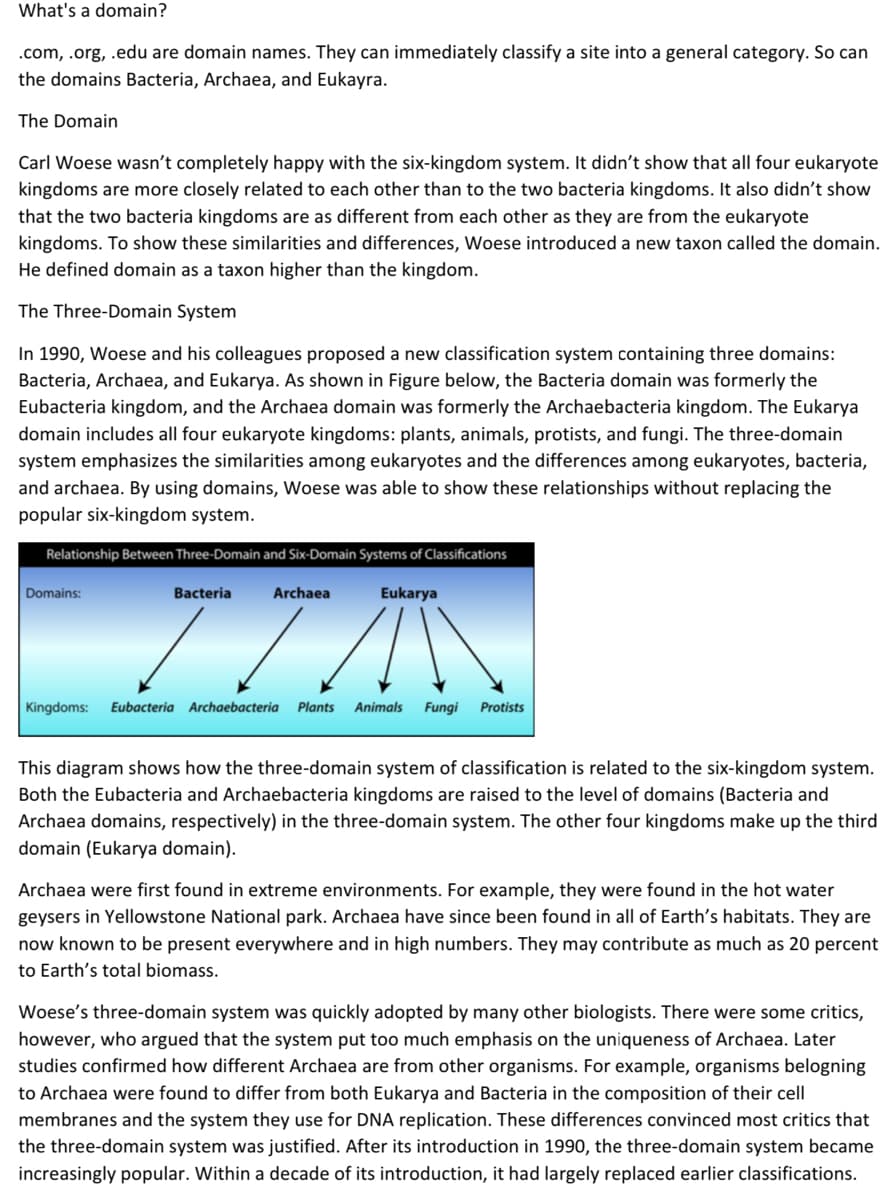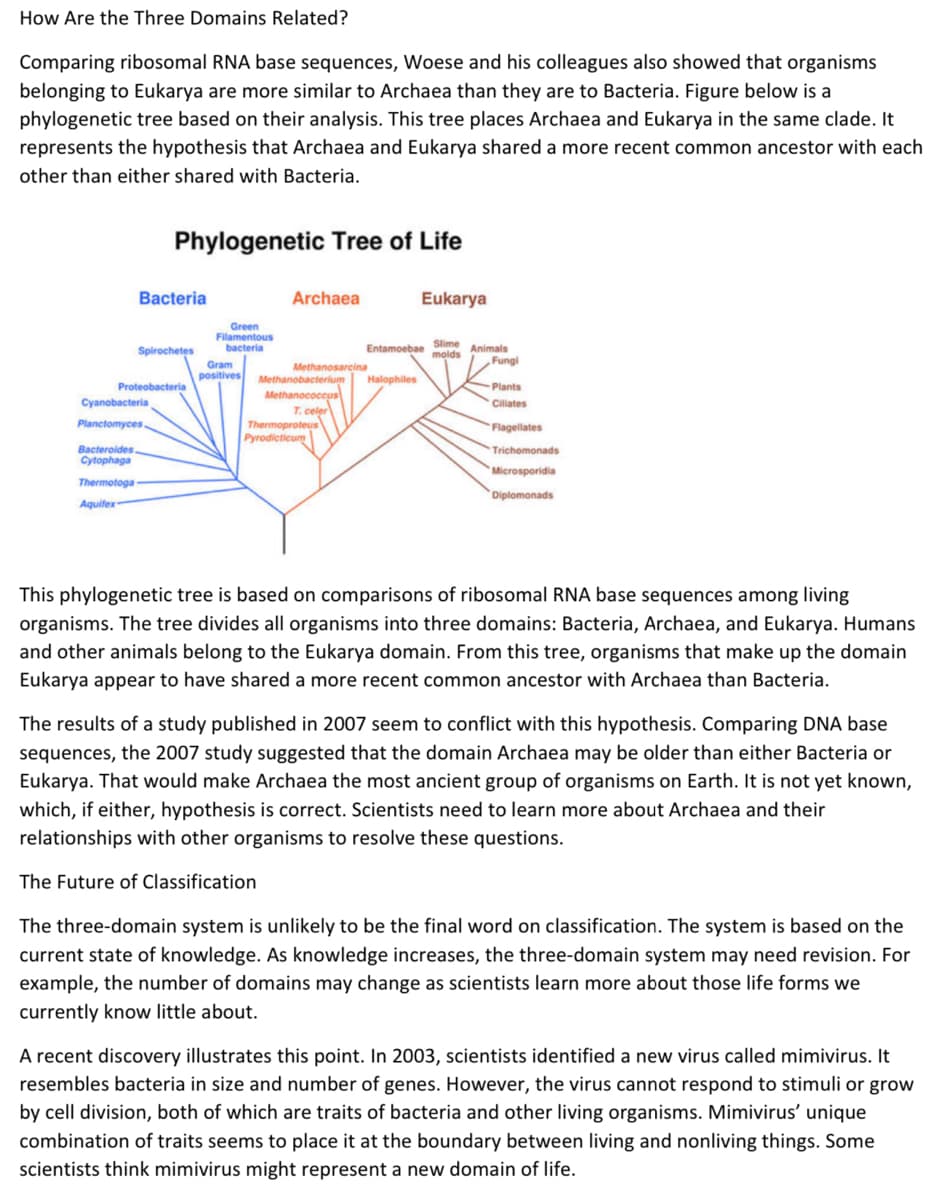Biology Today and Tomorrow without Physiology (MindTap Course List)
5th Edition
ISBN:9781305117396
Author:Cecie Starr, Christine Evers, Lisa Starr
Publisher:Cecie Starr, Christine Evers, Lisa Starr
Chapter1: Invitation To Biology
Section: Chapter Questions
Problem 9SQ: butterfly is a(n) _____ (choose all that apply). a. organism b. domain c. species d. eukaryote e....
Related questions
Question
Compare and contrast bacteria, Archaea, and eukarya.

Transcribed Image Text:What's a domain?
.com, .org, .edu are domain names. They can immediately classify a site into a general category. So can
the domains Bacteria, Archaea, and Eukayra.
The Domain
Carl Woese wasn't completely happy with the six-kingdom system. It didn't show that all four eukaryote
kingdoms are more closely related to each other than to the two bacteria kingdoms. It also didn't show
that the two bacteria kingdoms are as different from each other as they are from the eukaryote
kingdoms. To show these similarities and differences, Woese introduced a new taxon called the domain.
He defined domain as a taxon higher than the kingdom.
The Three-Domain System
In 1990, Woese and his colleagues proposed a new classification system containing three domains:
Bacteria, Archaea, and Eukarya. As shown in Figure below, the Bacteria domain was formerly the
Eubacteria kingdom, and the Archaea domain was formerly the Archaebacteria kingdom. The Eukarya
domain includes all four eukaryote kingdoms: plants, animals, protists, and fungi. The three-domain
system emphasizes the similarities among eukaryotes and the differences among eukaryotes, bacteria,
and archaea. By using domains, Woese was able to show these relationships without replacing the
popular six-kingdom system.
Relationship Between Three-Domain and Six-Domain Systems of Classifications
Domains:
Bacteria
Archaea
Eukarya
Kingdoms:
Eubacteria Archaebacteria
Plants
Animals
Fungi
Protists
This diagram shows how the three-domain system of classification is related to the six-kingdom system.
Both the Eubacteria and Archaebacteria kingdoms are raised to the level of domains (Bacteria and
Archaea domains, respectively) in the three-domain system. The other four kingdoms make up the third
domain (Eukarya domain).
Archaea were first found in extreme environments. For example, they were found in the hot water
geysers in Yellowstone National park. Archaea have since been found in all of Earth's habitats. They are
now known to be present everywhere and in high numbers. They may contribute as much as 20 percent
to Earth's total biomass.
Woese's three-domain system was quickly adopted by many other biologists. There were some critics,
however, who argued that the system put too much emphasis on the uniqueness of Archaea. Later
studies confirmed how different Archaea are from other organisms. For example, organisms belogning
to Archaea were found to differ from both Eukarya and Bacteria in the composition of their cell
membranes and the system they use for DNA replication. These differences convinced most critics that
the three-domain system was justified. After its introduction in 1990, the three-domain system became
increasingly popular. Within a decade of its introduction, it had largely replaced earlier classifications.

Transcribed Image Text:How Are the Three Domains Related?
Comparing ribosomal RNA base sequences, Woese and his colleagues also showed that organisms
belonging to Eukarya are more similar to Archaea than they are to Bacteria. Figure below is a
phylogenetic tree based on their analysis. This tree places Archaea and Eukarya in the same clade. It
represents the hypothesis that Archaea and Eukarya shared a more recent common ancestor with each
other than either shared with Bacteria.
Phylogenetic Tree of Life
Bacteria
Archaea
Eukarya
Green
Filamentous
bacteria
Spirochetes
Entamoebae Slime Animals
molds
Fungi
Gram
positives
Methanosarcina
Methanobacterium
Halophiles
Proteobacteria
Plants
Methanococeus
Cyanobacteria
Ciliates
T.celer
Thermoproteus
Pyrodicticum
Planctomyces.
Flagellates
Bacteroides
Cytophaga
Trichomonads
Microsporidia
Thermotoga
Diplomonads
Aquifex
This phylogenetic tree is based on comparisons of ribosomal RNA base sequences among living
organisms. The tree divides all organisms into three domains: Bacteria, Archaea, and Eukarya. Humans
and other animals belong to the Eukarya domain. From this tree, organisms that make up the domain
Eukarya appear to have shared a more recent common ancestor with Archaea than Bacteria.
The results of a study published in 2007 seem to conflict with this hypothesis. Comparing DNA base
sequences, the 2007 study suggested that the domain Archaea may be older than either Bacteria or
Eukarya. That would make Archaea the most ancient group of organisms on Earth. It is not yet known,
which, if either, hypothesis is correct. Scientists need to learn more about Archaea and their
relationships with other organisms to resolve these questions.
The Future of Classification
The three-domain system is unlikely to be the final word on classification. The system is based on the
current state of knowledge. As knowledge increases, the three-domain system may need revision. For
example, the number of domains may change as scientists learn more about those life forms we
currently know little about.
A recent discovery illustrates this point. In 2003, scientists identified a new virus called mimivirus. It
resembles bacteria in size and number of genes. However, the virus cannot respond to stimuli or grow
by cell division, both of which are traits of bacteria and other living organisms. Mimivirus' unique
combination of traits seems to place it at the boundary between living and nonliving things. Some
scientists think mimivirus might represent a new domain of life.
Expert Solution
This question has been solved!
Explore an expertly crafted, step-by-step solution for a thorough understanding of key concepts.
This is a popular solution!
Trending now
This is a popular solution!
Step by step
Solved in 2 steps

Knowledge Booster
Learn more about
Need a deep-dive on the concept behind this application? Look no further. Learn more about this topic, biology and related others by exploring similar questions and additional content below.Recommended textbooks for you

Biology Today and Tomorrow without Physiology (Mi…
Biology
ISBN:
9781305117396
Author:
Cecie Starr, Christine Evers, Lisa Starr
Publisher:
Cengage Learning


Biology Today and Tomorrow without Physiology (Mi…
Biology
ISBN:
9781305117396
Author:
Cecie Starr, Christine Evers, Lisa Starr
Publisher:
Cengage Learning
